#reusable components
Explore tagged Tumblr posts
Text
Creating a Reusable Component Library in Angular
Overview Are you tired of writing the same code over and over again in your Angular applications? Do you want to improve code reusability and simplify the development process? Look no further! Creating a reusable component library is the answer. Why Use a Component Library? A component library is a collection of reusable UI components that can be shared across multiple projects. It provides…
#Angular#Angular component library#Component Library#CSS#development#Front-end Development#Reusability#reusable components#UI development
0 notes
Text
Purecode | A significant advantage of React components is their reusability.
A significant advantage of React components is their reusability. Imagine building a skyscraper. Instead of creating each floor from scratch, you could construct one floor and replicate it as many times as required. Similarly, React components are reusable, making it possible to use the same code or assets across different parts of an application and adjust as needed.
#purecode ai company reviews#purecode#purecode ai reviews#purecode software reviews#purecode reviews#purecode company#React components#reusability
0 notes
Text
Learn how the development of reusable UI components helped significantly enhance UI and implement consistency across their other web applications.
0 notes
Text
This article delves into the significance, benefits, and best practices of using reusable components in software development.
0 notes
Text
Your Ultimate Guide to Reusable React JS Components for Turkey
Learn how reusable React JS components can transform your development process in Turkey. This guide provides practical steps and examples to help businesses create efficient, maintainable code.
Ideal for both business owners and developers, it offers strategies to save time and reduce costs. Enhance your project's productivity and deliver high-quality projects with these proven techniques.
0 notes
Text
React is actually kinda cool…. I hate to admit it but it makes html not suck ass
#.txt#there’s some leg work you gotta do esp for more complex projects#but for making your own custom and reusable components it’s fucking. really nice#like even for static webpages it’s better than nothing#object orientation is a good solution to a lot of problems despite what annoying csci YouTubers tell you
1 note
·
View note
Text
two colour pediatric soft mask mold
China 2k mold maker, offer multi shot oxygen soft mask, bi material baby mask, two colour pediatric soft mask, two tone children plastic reusable mask mold
#China mold#2 component mold#Bi material mold#multi shot mold#two color oxygen soft mask mold#2k baby mask mold#rotary mold pediatric soft mask#double children plastic reusable mask mold
0 notes
Text
Terragrunt vs Terraform: Battle of DevOps tools
Terragrunt vs Terraform: Battle of DevOps tools @vexpert #homelab #terraform #terragrunt #infrastructureascode #cloudinfrastructuremanagement #devops #terragruntconfiguration #dependencymanagement #remotestatemanagement
Infrastructure as Code (IaC) has become widely adopted by many, including in production environments, developers, and home lab enthusiasts to deploy infrastructure. Terraform is arguably one of the top tools used by DevOps professionals. However, there is another tool you may not have heard about called Terragrunt. What is Terragrunt? What about Terragrunt vs Terraform? Are they competing…
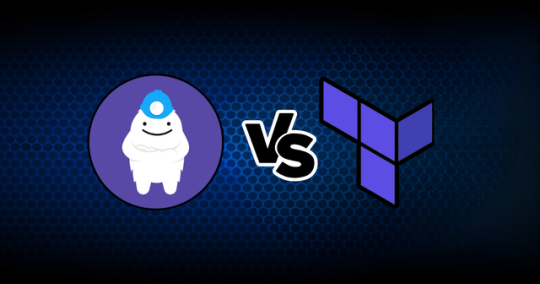
View On WordPress
#Cloud Infrastructure Management#dependency management#infrastructure as code#managing multiple environments#remote state management#reusable terraform components#terraform#terraform modules#terragrunt#terragrunt configuration
0 notes
Note
are n95s reusable?
When correctly stored and carefully doffed, yes. The filter material will outlast the other components of the mask. If you're going to reuse an n95, You need to make sure that the elastic has not been overly stretched and that the nose piece still has enough rigidity to create a good seal on your face. If the filter medium becomes discolored and dirty discard it. If you're ever unsure if the other components Are still working, Discard the mask. Masks that are wet or have gotten sweaty should be discarded if you cannot assure that they are dry as they can breed mold and other nasties you can inhale that make you sick. Dry masks can be kept in paper bags for several days to help make Sure that no pathogens are alive in them. Early on in the pandemic, My partner was cycling through 5 masks a week at work using a similar system, and she didn't get sick while working childcare.
#mask up#public health#wear a mask#wear a respirator#pandemic#covid#still coviding#covid 19#coronavirus#sars cov 2
189 notes
·
View notes
Text
when a water bottle became a warning sign
remember when stanley cups were everywhere? they showed up in car cupholders, tiktok hauls, and probably even your dreams. people sprinted through targets at 7 am to grab limited edition drops. for a while, having the cup meant hydration, status, and aesthetic all in one. but now, the hype is slowing — and we’re left to ask: what was all that for?
how we got here
stanley tumblers weren’t always trendy. they were originally rugged, functional thermoses marketed to construction workers and outdoorsy types. then tiktok found them. influencers praised their colorways, size (40 oz!), and vibe — and suddenly, stanley cups became the cup.
limited drops triggered frenzy. entire aisles were wiped out in minutes. some people collected them like sneakers. others bought every color “just to have options.” the resale market exploded. some went for $100+.
but this wasn’t just about hydration. this was haul culture.
the problem with haul culture
the stanley craze tapped into something deeper: the social media pressure to consume constantly and publicly. haul videos — where influencers unbox massive purchases — normalized overbuying. it wasn’t about needing a water bottle. it was about owning the trend.
and it didn’t stop at stanleys. people started buying accessories: straw toppers, silicone boots, name tags. if you weren’t accessorizing your cup, were you even trying?
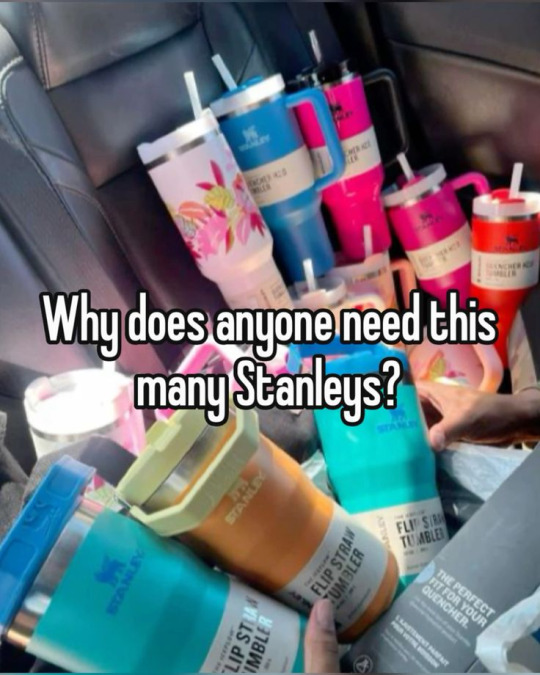
environmental impact
all that hype had real consequences:
plastic overload: despite being reusable, many stanley cups are made with plastic components. producing millions of them increases emissions and waste, especially when people buy multiple.
fast consumer cycles: the constant color drops encouraged more buying, not reuse. that defeats the purpose of sustainability.
landfill overflow: as the trend fades, many cups will be discarded — not because they’re broken, but because they’re out of style.
it’s a form of “green overconsumption” — buying reusable goods in excess under the illusion of sustainability.
the decline
like most trends, stanley’s grip is loosening. people are realizing they don’t need five identical tumblers. gen z is especially starting to question the logic behind impulse buying in the name of “self-care.”
tiktok creators are now posting videos like “things i regret buying” or “how minimalism saved my wallet.” the pendulum is swinging back.
so what now?
stanley cups aren’t evil. they are reusable. they do help people drink more water. but the obsession around them reveals a bigger issue: we keep trying to shop our way into a better lifestyle.
if we want to seriously tackle overconsumption and pollution, we need to think beyond trends. that means:
buying one good thing — and sticking with it.
not collecting items just because they’re cute.
resisting the pressure to haul for content.
normalizing “i already have one” as a reason not to buy.
final sip
the stanley cup hype taught us something important: even the “good” products can turn harmful when they’re part of a cycle of mindless consumption. reuse doesn’t count if you’re just rotating between 12 colors.
so if you’ve got a stanley cup — great. use it. love it. keep it for years. but maybe don’t buy another just because it matches your hoodie.
the planet doesn’t care if it’s periwinkle or peach.
#economy#current events#sustainableliving#climate crisis#overconsumption#conscious consumption#deinfluencing#influencer culture#slow living#greenwashing#eco lifestyle#climate action#climate change#plastic#water bottle#minimalist#mintconditioned#stanleycupcraze#viral buy#questionthetrend
22 notes
·
View notes
Text
Building a Component Library for NextJS: A Guide to Reusable UI
Building a Component Library for NextJS: A Guide to Reusable UI Have you ever found yourself rewriting the same UI components over and over again in your NextJS projects? Have you struggled to maintain consistency and efficiency across multiple applications? If so, it’s time to consider building a component library. A component library is a collection of reusable UI elements that can be shared…
#building component library#Component Library#Design#development#front-end#NextJS#NextJS component library#reusable#reusable UI#UI
0 notes
Note
Hi there, Love your work! I'm also doing stuff in Unreal and it feels like it's rarer to find other indie devs using it. I love how clean all your UI feels, and UI is something I seem to really struggle with.
Do you have any recommendations for workflows / tips / sources etc for getting better at UI?
Also I'd love to know more about the material / shader workflow for your latest post if you have more information anywhere.
Thanks :)
Hello there! Thank you!! I hope you don't mind me answering publicly as I feel like some people might be interested in the answer!
I really appreciate your UI (User Interface for those not knowing the acronym) compliment as it's something I've spent a long time working on and specializing in, in my career as a software engineer. UI/UX often goes completely unacknowledged or taken for granted even though it takes a lot of time and hard work to create and develop. In the engineering world I frequently had to advocate for and explain user experiences to those who didn't have as deep of an appreciation for UI or a very sophisticated understanding of why a good, visually appealing user experience makes, or on the flip side, can break everything. I think it's a very challenging, overwhelming topic to grasp and communicate, but just by being interested in it you're already way ahead!
There's a lot going on with UI. From visuals to knowing common design elements to successfully conveying a story to the user to implementation to testing to designing for accessibility to animation and I probably didn't cover everything with that run-on sentence. There's frontend engineers out there whose role is solely to maintain and improve UI component libraries for companies. And that's without throwing games, whose UIs are all uniquely visually tailored to their experiences, into the mix... I could keep going on about this honestly, but I'll get to what I think you can do personally! 1. Learn about common design patterns. What's a toast? What's pagination? What's a card? Little things like that. These apply to all software UI/UX, including video games- and knowing these off the top of your head will make it so much easier for you to invent your own UI designs and patterns.
2. Study the UI in the everyday applications you interact with. Step through menus and think about how you got from point A to point B. Take a moment to think about the why someone put a button where they did. Study the UI in your favorite video games, too! Take a lot of notes on what you think works really well and what you think doesn't. And also there's online resources that are great for inspiration. I personally spend a lot of time on the Game UI Database. - https://dribbble.com/ - https://www.gameuidatabase.com/ 3. Don't be afraid to start with basic sketches or even just simply representing everything with grey boxes. All my UI starts out as really crappy sketches on paper, or tablet sketches on top of screenshots. Visualize your ideas and then keep iterating on them until you've got something. For example, I went from this:
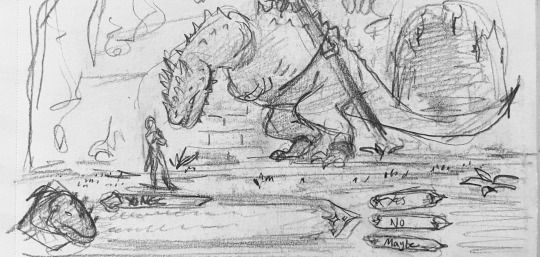

To this. (And come to think of it I might actually still want to make those cooler looking buttons in my sketch) 4. Break everything out into pieces and individual components. A good UI is made up of building blocks that you can reuse all over the place. That's how it stays consistent and also saves you a lot of stress when you need to go in and update components. Instead of a million different looking UI pieces, you just have to update the one! These individual components will make up your very own UI Component Library, which will be the standardized design system and source of reusable components for your project. This also applies to your visual elements that don't do anything (like I personally have a whole mini library of diamond and star shapes that I reuse everywhere).
For reference, here's a breakdown I made of my Inventory UI. On the right, I've labeled most of the individual components, and you might be able to see how I'm reusing them over and over again in multiple places.
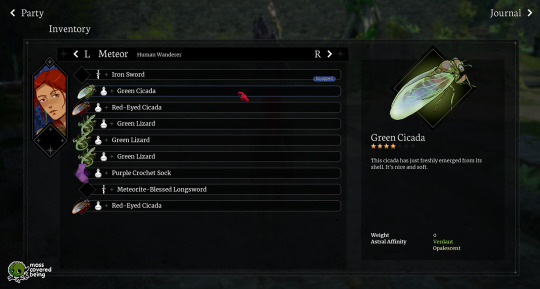
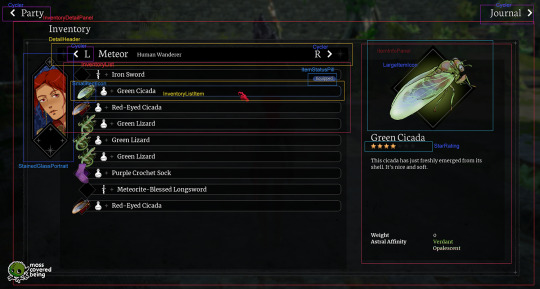
5. Spend some time listening to designers talk, maybe befriend some designers! Many of them have an unique, interesting view of the world and how we interact with it even beyond just software. Their perspectives will inform yours.
6. Test your UI on users whenever you can. Get feedback from others. This is the best way for you to see what works and what doesn't. As game devs we spend so much time with our games it's easy for us to lose sight of the full picture.
7. Be patient and don't give up. Continue to be open to expanding your knowledge. These UI skills take time to develop. I personally am still learning even after like 10 years of doing it. Coming up with the visual elements is very challenging for me and I spend a lot of time rearranging things in photoshop before I actually start coding anything at all in Unreal.
Whew, that was a lot, but I hope that gives you some thoughts and a place to start!
I don't have any posts out there about Blender/Unreal shader workflows right now, but I'll consider making another post sometime soonish. I appreciate you asking and you're welcome! :)
23 notes
·
View notes
Text
So, a thing I've seen in fic recently is characters using single use water bottles all the time, and I was reminded that not everyone has a massive collection of reusable water bottles covered in stickers, so I'm curious:
I'm also curious where you're from and if this has an age component. Please reblog for sample size!
#poll#water#i drink from a reusable bottle and filtered#although i would use tap - our fridge just has a filter and dispenser so it's easy and cold#and i'm in my 30s and living in the pnw in the us#my mom doesn't like the taste of water so she just doesn't drink it if she can help it
54 notes
·
View notes
Text
FUCKED UP WIZARD TIPS
A Tip For: NecromancerS
pad! out! your! zombie! hordes! with! what! we! like! to! call! *Shambling Falsehoods*
a *Shambling Falsehood* iS vERY sIMPLE tO mAKE.
You Will Need The Following Materials: *1 humanoid corpse, 4x the standard equipment and materials for reanimation rituals, needle and thread (optional)*
*step one*
Carve up a corpse until you have separated it into the following component groups: *skin, bones, organs & muscles & offal, blood*
*step two*
Reanimate each group of components. You should end up with: A Skeleton, A Forsaken Shell, A Flesh Golem, And A Blood Elemental.
*step three*
Wrap the skeleton in the meat of the flesh golem.
*step four*
wrap your flesh golem in the skin of your forsaken shell
*step five*
fill the remaining empty space within with your blood elemental
*step six (optional)*
Stitch up the opening of your forsaken shell, and you are done! You now have a SHAMBLING FALSEHOOD.
We recommend placing these sporadically within zombie hordes for best results, because they move like zombies, but once someone cuts them, they now have to deal with skin attempting to choke them, a blood golem attempting to drown or cut them, a flesh golem, and a skeleton. It may not be a HUGE powerhouse, but! it’s! unexpected! which! gives! it! an! advantage! and! it’s! pieces! can! be! surprisingly! effective! EspeciallY WheN BeinG AssisteD BY A HordE OF ZombieS, Makes For Pretty Intense Nightmare Fuel. Also easily reusable! Stitching The Forsaken Shell Simply Makes It Blend Into Your Horde Easier, But You Don’t Need To Do It.
12 notes
·
View notes
Text
The Art of Asset Reduction: VNConf 2024 Write-Up
youtube
This is a write-up for my Visual;Conference 2024 talk on asset reduction: presentation of scenes with reduced art labor.
I will discuss how to reduce production requirements via various methods of asset presentation and staging, walking you through case studies of existing visual novels. This talk will guide you to answer the question: How do I fulfill my project scope without asset bloat?
This is an art talk that assumes you have already scoped down your story and have created a list of scenes that you need. This is not a talk about scoping down your game's story.
You have scenes you need to make. How are you going to make them (and with style)?
Abstraction
Cut-ins
Reduce
Reuse
-
I. Abstraction
I start off with abstraction as a reminder that visual novels are a combination of visual and novel (amongst other aspects)
Abstraction
Abstraction is a strong tool for bringing focus to the writing, highlighting ambiguity and setting the mood with colors.
Examples I mentioned in my talk include:
Black screen
Solid colored screen
Sky BG
Of Components
The mood-setting power of abstraction also extends to scenes with characters, especially CGs.
As again, abstraction draws focus to what you choose to emphasize: the characters.
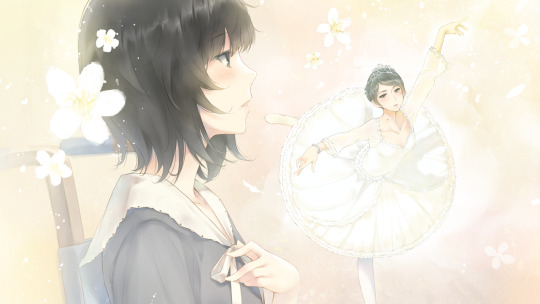
(FLOWERS -Le volume sur ete-)
They are gay. Thank you for coming to my VNConf talk.
-
You can similarly abstract characters.
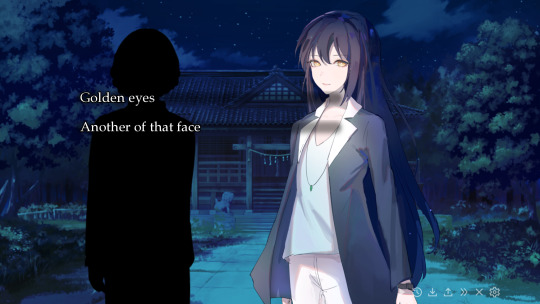
(Lachesis or Atropos)
Consider representing irrelevant characters (e.g., NPCs) as silhouettes. The reader can fill in the details within the shapes themselves.
Silhouettes are especially great for crowd scenes where you want to draw focus to the main characters.
This will be a recurring theme:
What do you really need to draw?
-
II. Cut-ins
One common not-quite full screen piece of art you'll see in many visual novels is the cut-in.
The cut-in typically consists of the:
Item/focus
Frame
And is often for topics such as objects or small animals, which may exist in the scene but may not be within the same frame of reference as the background and sprites.
The separate framing informs the players that the item is "separately framed."
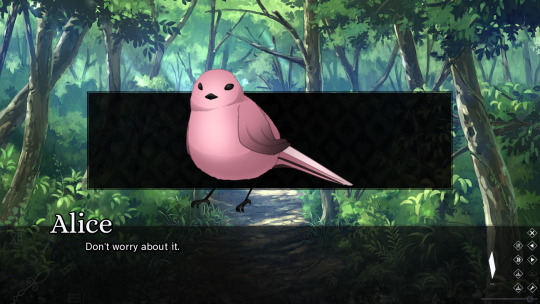
(Who is the Red Queen?)
For example, this small bird is not huge and would not be the size of a character's head even had a sprite been on screen.
The Foreground-Backdrop Heuristic
Cut-ins make strong use of what I refer to as the "foreground-backdrop heuristic."
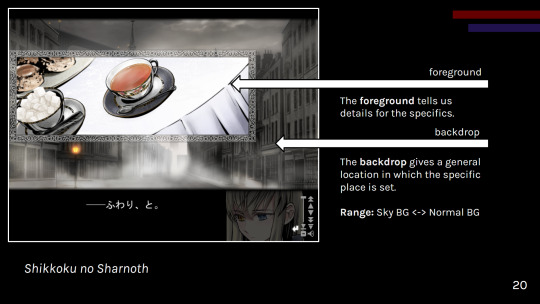
(Shikkoku no Sharnoth)
A general backdrop informs the reader of a broad location or scene (especially if characters are present). Then a more specific foreground (the cut-in) informs the reader of the specifics.
As the foreground cut-in is in a different frame, the pairing of the two helps create a mental model of the space in the reader's mind.
Cut-ins can be used for:
Backgrounds (mix and match foregrounds with a backdrop)
Reduced CGs
Presenting existing assets in a different frame of reference
CG variants
Try tackling your visual presentation in a layered, comic book-esque fashion with cut-ins!
Just be careful about clutter.
Whether you want to go for the layered cut-in style, the 3d stage cinematic style, or a combination of the two, make sure you have a vision before you jump in.
SD CGs
I had to make an obligatory mention of SD "super deformed" CGs in this talk, so here it is in the write up as well.
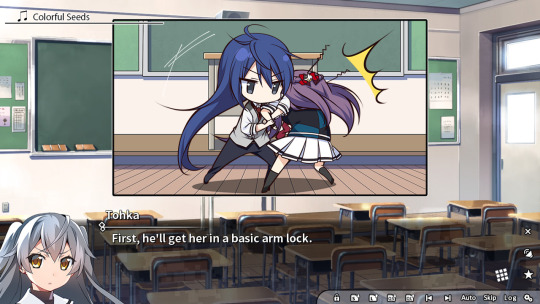
(Grisaia: Phantom Trigger Vol. 1)
SD, chibi. However you call these, they're great for playful scenes that might require more art than your classic sprite-background combination.
What SD CGs do best is that they:
Fulfill the role of a CG
Are easier to draw than fully rendered non-chibi art
Can be distributed to different artists to reduce artist workloads due to style difference
Just keep in mind that a simplified CG is still a CG and thus may lack reusability.
Consider what scenes really need a CG.
-
III. Reduce
Now, consider asking yourself: "Does what a player does not see need to exist?" (mostly applicable for games with opaque UI)
Yet, what you need to draw is what you need to draw. How can you reduce the work in what you need to draw?
One option is:
Palette Limitation
You've heard of gray scale games, but don't forget about other ways of limiting your palette to reduce workload.
Dramatic, mood setting color power
Less rendering work
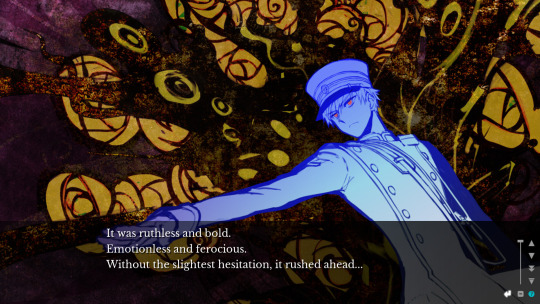
(Sona-Nyl of the Violet Shadows)
A similar idea can be applied to NPCs for a more detailed take on silhouettes.
-
IV. Reuse
Lastly, please remember to be economical and reuse assets as necessary. One of the great joys of cut-in BGs, for example, is reusability.
I had to give an obligatory mention to CG variants in my talk, such as:
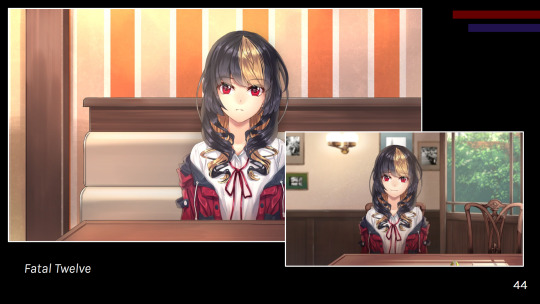
(Fatal Twelve)
However, overall, you never know when you'll want to use various components of your art elsewhere such as intermixing CG and sprite art.
Please keep your working layers if possible.
Other reuse examples:
UI (especially in episodic games)
Gameplay (e.g., Kogado's rhythm game)
Consider asking your programmer to work on a framework to reuse, reducing repeated code work.
-
Conclusions
All in all, you can make your game.
And it doesn't need to be hellish on your budget or timeline.
If you take anything away from this talk, let it be to:
Prioritize reusable assets
Maintain aesthetic; avoid clutter
Display important scenes
Do not scope up; aim for a set goal
A scene can be presented in many stylish ways, some of which will suit your workflow better than others.
So, go on. Make your game!
-
Interested in my works? Find me on itch:
And check out my newsletter:
-
VNConf 2023 Talk Write-up:
#visual novel development#vnconf#visual novel#vn#vndev#development guide#devlog#game development#talk write-up#gamedev#indiedev#this talk is also a yuri visual novel recommendation (kind of)#lachesis or atropos#shiei no sona-nyl#fatal twelve#grisaia phantom trigger#shikkoku no sharnoth#flowers visual novel#who is the red queen?
55 notes
·
View notes
Text
You should be able to build and share html components easily. For example: you build a website, during building this site you build reusable cards, you mark these out as components, write some metadata about the components and then people can find and reuse/remix them either through a search engine or by going through your site
I think when I have the time I'll implement this for html.lgbt so people can try it out and see if it's worthwhile.
18 notes
·
View notes